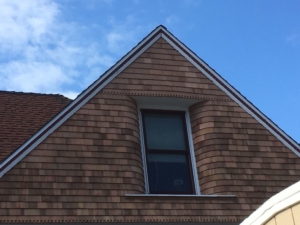Decorative Shingles – A Short History

From www.decorativeshingles.com
When mankind first started to build shelters, decoration became a part of the process. The overlapping of leaves, straw, and thatch along with the weaving of reeds, grasses and other fibres were part of man’s early, self-modified environment.
Over the centuries, patterns and decoration have become a part of manmade surroundings.
Modern structures appear as a collection of regular patterns made by bricks, stones, framing, siding, roofing, glass, tile, mouldings and panelling. By their very nature, these joined materials have become important elements of overall design.
Building materials are designed for structural considerations foremost. Bricks are laid in a staggered pattern because it gives the wall its maximum strength. Leaded glass allows just about any shape as long as it is strong enough and keeps out the wind and rain. The staggered and overlapping pattern of roofing slates and shingles is necessary for shedding water. Because of this basic consideration, weather resistant shingle designs are severely restricted when compared to the flexibility of other materials such as ceramic & mosaic tiles, parquet and inlaid flooring.
The enthusiasm for decorative millwork occurred when labour was enjoying a large increase in productivity brought on by the advancing industrial age. Mechanization, electricity and power tools were making a lot of basic construction tasks easier. This freed a lot of labour to work on decorative flourishes without incurring excessive additional costs.
The Victorian era was an age of intricate details and decorative shingles seemed to always be a part of this era. Many Georgian and Victorian buildings were roofed in clay tiles or slate. Gable ends and dormer walls were often clad with decorative slate and tiles.
Early settlers in North America used wood shingles from local species such as Cypress, Pine and White Cedar. Once easy access to the forests of western North America were established with the trans-continental railroads, Western Red Cedar became a favourite exterior finishing material. It was light, easy to work with, inexpensive, resisted rot and insects, and lasted extremely well on roofs and a lot longer on exterior walls.
Cedar trees often grow to great heights and thicknesses where their lower trunks are clear of knots, yielding the most valuable grade of wood; Clear edge grain. This cut of wood is universally prized, no matter what the species for its structural stability, strength and resistance to warping and splitting. For roofing purposes, edge grain and completely knot free are the requirements for a grade one shake or shingle.
Shingles can last for well over a hundred years if they are protected from the elements (eg; painted or on protected vertical walls). Cedar roofs do not last as long. As a result, all remaining examples of decorative shingle work from the late 1800’s and early 1900’s are of shingled walls, the original roof having long been replaced.
